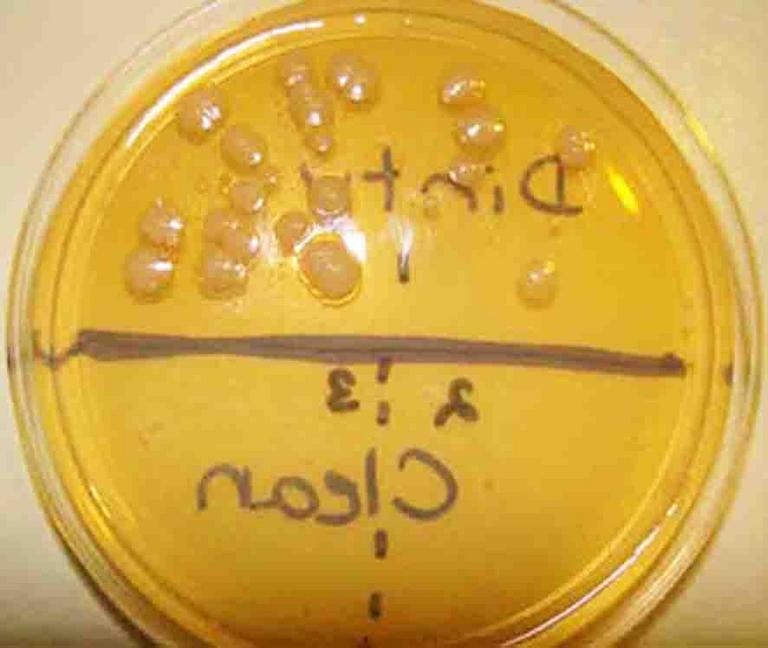 | ||||
How to Clean and Sanitize
Gardening Tools & Pots
Microbiology in the Home from Science Prof Online
Gardening equipment should be regularly cleaned and sanitized to reduce transmission of diseases and pests that can affect plants, such as bacterial infections, plant viruses and eggs of harmful insects. Cleaning tools and garden pots is not a difficult process, but needs to be done properly in order to be effective. See the photos at the end of this article for a visual guide to this process.
Article Summary: Clean-up is not the most enjoyable gardening task, but, to grow healthy plants, it must be done. Here's a step-by-step guide to cleaning and sanitizing garden equipment.
How to Clean and Sanitize Plant Pots & Gardening Tools
 | ||||
You have free access to a large collection of materials used in a college-level introductory microbiology course. The Virtual Microbiology Classroom provides a wide range of free educational resources including PowerPoint Lectures, Study Guides, Review Questions and Practice Test Questions.
Page last updated: 6/2014
SPO VIRTUAL CLASSROOMS
 | ||||||
 | ||||||
SPO is a FREE science education website. Donations are key in helping us provide this resource with fewer ads.
Please help!
(This donation link uses PayPal on a secure connection.)
Preparing Area for Garden Equipment Cleanup
- It’s best to have a double sink available; one sink for soapy water and one sink for rinsing.
- Place a towel or a dish rack on the counter, next to the rinsing sink, to allow cleaned materials to drain.
- Have large waste basket and laundry basket nearby. The laundry basket can be used for transporting cleaned, dried materials to the location where they will be stored. If your pots are full of old soil, also have a garden tub available for hauling old dirt out to the compost.
- Fill one sink with hot soapy water, and the other with cool rinsing water.
Preparing Garden Tools and Pots for Cleaning
- If the dirty gardening equipment is piled up in or near the sink that will be used for cleaning, the pile will need to be moved out of the way. The floor next to the cleaning area works well, or a laundry basket.
- Before washing the gardening equipment, remove any loose dirt. This will reduce the number of times the wash water will need to be changed. Tap and shake pots and tools over the waste basket to shake dirt free.
Materials Required to Clean Gardening Equipment
In addition to the soapy water and the rinsing water, the following materials will also be needed:
- Scrub brush
- Dish cloth
- Drying towel
- Large towel folded next to rinsing sink to set wet equipment on
- Spray bottle of bleach solution mixed to sanitizing strength (20 to 1 ratio, water to bleach)
Any tools that have moving parts, such as garden shears, should not be submerged in water. Clean these tools with a damp cloth, sanitize with rubbing alcohol, and then oil the moving parts to keep the tool in good working order.
Cleaning and Sanitizing Garden Equipment
- Thoroughly clean the first batch of materials in the soapy water.
- Dip cleaned equipment in rinse water, then let excess water drip off.
- Spray each piece of cleaned and rinsed equipment with bleach solution and set back in drying area (towel or dish rack). Bleach solution must remain on the materials being sanitized for 10 minutes in order to kill bacteria and destroy other pests.
- While waiting for the bleach solution to work on the cleaned materials, put the next batch of dirty pots and tools in the soapy water and wash.
- When wash water becomes dirty, drain, rinse sink and then refill with soapy water. Depending on the amount of equipment to be cleaned, and how dirty it is, the washing sink may need to be drained and refilled several times.
- Rinse cleaned, bleached materials one more time in the rinse water, and then set them aside to drain.
- Towel dry and stack clean materials in laundry basket.
- Once rinse water sink is again available, rinse the second batch of equipment being cleaned and repeat procedure.
The overall series of steps for cleaning gardening equipment is: wash, rinse, spray with bleach (let sit 10 minutes), rinse again, dry. Although it takes time to clean gardening tools in this way, it’s is well worth the effort, and will pay off in healthier plants.
 | ||||||
 | ||||||
HOME MICROBIOLOGY EXPERIMENT FROM SPO
TSY agar with sample from dirty dishes on top (note bacterial colonies that grew), and sample from cleaned dishes on bottom.
- Microbiology In the Home: How to Sanitize Your Home and Keep Your Family Healthy
- Clean Kitchen Tips: How to Kill Germs and Sanitize Surfaces
Few supplies are required: Dish soap, bleach spray, rubber gloves, a scrub brush, rag and towels for drying.
When cleaning and sanitizing garden tools and pots, it is best to have a washing sink, a rinsing sink and a third area where cleaned dishes can be spay sanitized with bleach and sit to dry. Use a clean pot with draining holes as a sieve in which you can wash potting stones and rocks.
Photo Guide to Cleaning & Sanitizing Gardening Tools and Plant Pots
More Gardening Articles and Microbiology in the Home
Dirty pots and garden tools can pile up fast, and it's easy to be tempted to replant into a dirty pot. But taking the time to wash and sanitize will lead to healthier, more robust potted plants.











